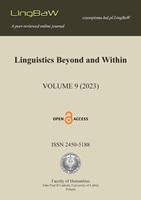Hypocoristic palatalization in Basque and historical applications
Hypocoristic palatalization in Basque and historical applications
Author(s): Jackson WolfSubject(s): Phonetics / Phonology, Historical Linguistics
Published by: Wydawnictwo KUL
Keywords: diminutive; phonology; historical linguistics; autosegmental; OT;
Summary/Abstract: This paper examines the processes of expressive palatalization in the Basque diminutive. Basque has two forms of the diminutive, a list of inflectional suffixes and a method of palatalization with specific phonological requirements. A speaker will first palatalize any coronal sibilants in the word. If there are none, then a dental obstruent that has a palatal counterpart is the next candidate. If there are again, none, then the last candidate is a dental coronal, but only the consonant on the leftmost edge. However, if there is a sibilant and a dental consonant, only the sibilants are palatalized. If there is a dental obstruent and a dental sonorant, only the obstruent is palatalized. To describe this process, I adopt an OT approach and an autosegmental approach to determine where the [+palatal] inflection morpheme can attach. Finally, I show the application of unworking the hypocoristic formation through internal reconstruction of Basque in animal names to produce two reconstructions.
Journal: Linguistics Beyond and Within (LingBaW)
- Issue Year: 9/2023
- Issue No: 9
- Page Range: 224-237
- Page Count: 14
- Language: English

